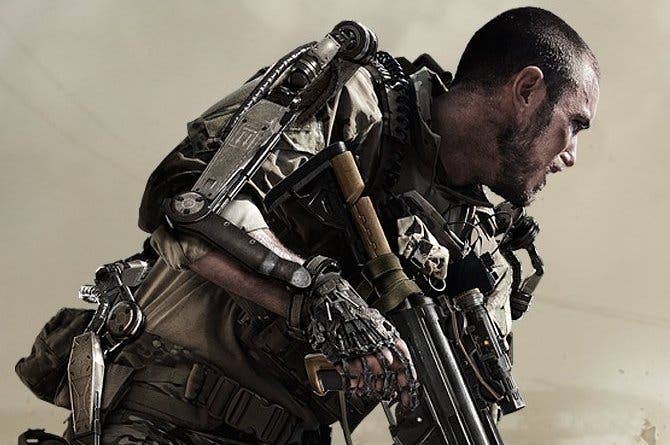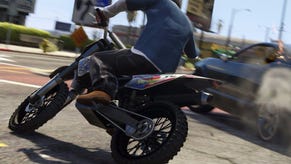Performance Analysis: Call of Duty: Advanced Warfare
Xbox One campaign gameplay runs more smoothly than PlayStation 4.
After a spell in development lingering at 882p and 900p pixel-counts, it's now confirmed that the Xbox One version of Call of Duty: Advanced Warfare uses a dynamic scaling model - rendering at resolutions between 1360x1080 to the full 1920x1080, depending on the intensity of the in-game action. As announced by Sledgehammer co-founder Michael Condrey during a Reddit AMA, this marks a stark upgrade over the console's 720p delivery in Call of Duty: Ghosts, bringing it much closer to the crisp, native 1080p image enjoyed on PlayStation 4. But with its resolution in flux, just how well does image quality fare on Microsoft's platform in comparison? And just as crucially, how does performance hold up between the two?
The resolution issue is an interesting discussion point. For the most part, it works as you'd expect. According to our measurements, the bigger battles in Advanced Warfare's opening stage do indeed operate with a cut 1360x1080 resolution on Xbox One. Clarity on geometric edges is affected - producing blurrier outlines in our matched shots below - as well as creating a muddier appearance to sub-pixel sampling across trees and grass. The opening shot of Seoul's skyscrapers is a good example of this, where window details on each building appear cleaner on PlayStation 4.
But while this is telling in static shots, the difference is harder to tally up in action. Sledgehammer's ground-up rebuild of the Call of Duty engine pushes heavily on post-process effects, such as full-screen (and per-object) motion blur, a depth of field filter and a sparing use of chromatic aberration during play. As a result, the stand-off between the Xbox One's minimum 1360x1080 and PS4's full 1920x1080 is less perceptible during hectic firefights, with fast camera sweeps often blurring these high contrast edges.
The Xbox One produces a native 1920x1080 resolution too, but only in subdued moments. Clinical interior areas, such as Atlas' labs, tend not to strain the hardware enough to enforce a downsized framebuffer. Areas with few NPCs also opens the doors to the full HD resolution, where every on-screen element is perfectly matched down to the last pixel. These moments tend to be uncommon, however, especially given the frenetic, action-focused direction of each mission. While it's clear that resolution frequently hangs at the 1360x1080 point, it's still uncertain what resolutions are deployed between this lowest point and the full HD top-end - an area we intend to inspect more closely in the upcoming Face-Off.
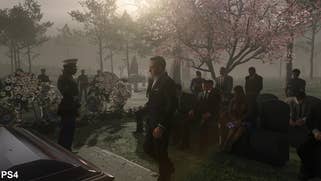




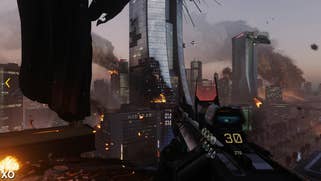

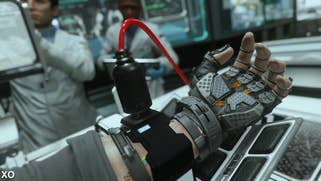


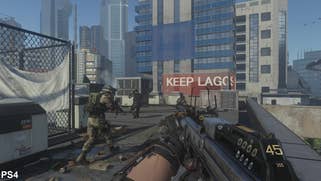
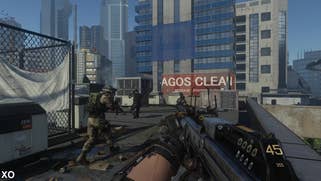
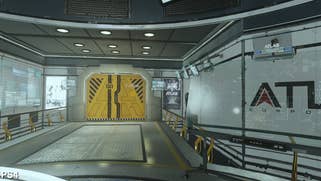
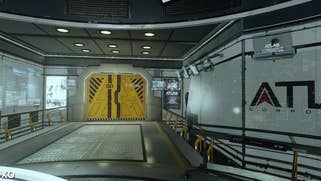
In the main, asset quality is identical between the two platforms. From the handling of shadow rendering to texture detail, there's little to distinguish the Xbox One release from the PS4. But based on the first three campaign levels we've analysed in-depth, the larger disparity is in performance rather than in-game visuals.
With patch version 1.04 installed, the PS4 version's constant 1080p output comes at a price. We catch dips between the 50-60fps lines during battles through Seoul's streets - with drops to the high 40s caught when throwing the 'threat' grenades to scan the area for enemies. Even in perfectly matched scenes, the Xbox One's performance tends to hold at a perfect 60fps by comparison.
The only concession on Microsoft's platform, besides its variable resolution, is the use of adaptive v-sync. In practice, this causes frames to tear during spikes in concurrent alpha effects, or scenes involving multiple allies on-screen. While very rare, this helps the platform avoid any delay in getting the next frame on screen, in cases where the hardware's resources are unexpectedly pressed. By comparison, the PS4's approach is to engage v-sync permanently, waiting until the next frame is rendered in its entirety, causing a touch more stutter.
There are some anomalies during play too. The first is the semi-frequent stutter on both platforms, coinciding with the game's checkpoint system. This causes a brief hiccup to play every time the game's auto-save kicks in, which unfortunately for Call of Duty, tends to be at the end of each hallway. Towards the end of our video, you'll also notice momentary dips to 30fps during an on-rails segment. This affects both PS4 and Xbox One as part of a slow-motion effect while jumping between vehicles. It's an anomaly, thankfully, and doesn't represent general gameplay.
Right now, the majority of our testing has concentrated on the campaign mode, where Sledgehammer Games really pushes the boat out visually. However, we briefly dipped into the multiplayer mode on both systems in order to gain some first impressions on resolution and frame-rate. We'll need to test this much more thoroughly across a range of maps, but initial results suggest that the dynamic resolution switch is disabled on Xbox One, leading to a static 1360x1080 presentation throughout. Meanwhile, PS4 locks to native 1080p. This is significant, bearing in mind that multiplayer is the key focus for many COD fans, but the good news is that overall gameplay frame-rates seem just as solid as our recent testing on the Gamescom and EGX builds - a state of affairs that extends to both systems.
All in all, our initial test session of Call of Duty: Advanced Warfare's campaign on Xbox One shows an enormous improvement over the E3 demo we looked at a while back. Frame-rates hit the 60fps target with greater consistency while the 1360x1080 resolution marginally boosts the overall pixel rate compared to the 900p version we played recently at EGX 2014. Overall, the final game is a satisfying upgrade from the previous builds we've played on the Microsoft console.
Up until now, the PlayStation 4 version remained an enigma. Running at 1080p, its presentation remains king of course, while Microsoft's hardware only occasionally shifts up to that resolution, typically in less demanding areas. However, the less consistent 50-60fps performance level on Sony's platform is a surprising state of affairs, and bearing in mind that frame-rate is king in Call of Duty, we're surprised that the dynamic scaling tech wasn't deployed on both platforms.
On balance, it's an impressive showing for both platforms, with few obvious asset-side differences caught during our initial testing. For our full Face-Off feature, we'll look more closely into the single-player game and delve deeper into the multiplayer mode too. On top of that, we'll be assessing the PC version in terms of its rendering feature-set, not to mention its overall performance level across a range of hardware.
